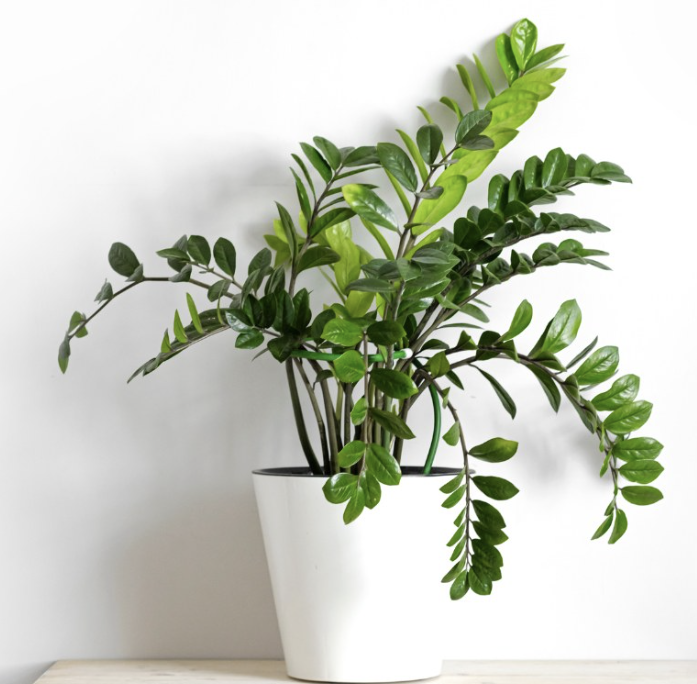Are the leaves of your Zamioculcas zamiifolia (or Zanzibar gem) plant turning brown? There’s no need to panic, there are a few things you can try to get them back to the striking green they should be. This blog post will look at the potential different causes of brown leaves, what you should do, and extra tips and tricks to make your plant happy.
ZZ plants are known for being low maintenance house plants, which makes them a favourite for plant parents and interior designers alike, fitting perfectly into spaces like the living room, kitchen & bathroom, or home office. But even these tough plants can run into a range of issues.
What signs to look out for early on
If you catch things early, it’s much easier to get your plant back to good health. Here are the early signs to keep an eye on:
Colour changes:
Brown Leaf Tips: The tips of the leaves may start turning brown before visible on the whole plant
Colour changes: The the dark, healthy green of the leaves may start fading, and looking dull.
Spots: either brown or yellow spots may appear. This can appear as small, pinpoint spots before growing in size.
Texture changes:
curling and wrinking: the leaves may start to become curly or wrinkly before colour changes. This can also be due to dry air or lack of humidity.
Dry, crispy edges: The zz plants leaves can start to dry out and become crispy before colour changes.
Texture changes: a thick and firm leaf of a healthy plant can start feeling soft and thin before changing colour.
The most common reasons of brown leaves
Too much sun
The main cause of brown patches on the ZZ plant’s leaves is sunburn. This can be more of a cause during Summer months. The easy solve for this is to move it out of direct sunlight. For a lush, healthy plant, place it in bright light, out of direct sun. This plant will tolerate different environmental conditions, so you can keep it in lower indirect light levels. Moving your plant can shock it. when you move it out of direct sun, you need to be sure to acclimate it gradually to its new position. Make sure you wipe your plant’s leaves with a damp cloth to keep them clean. This will keep them looking shiny, but will also allow enough light to reach them.
Too much water
Another cause of discoloured leaves is overwatering. ZZ plants are sensitive to excess water, they prefer to be underwatered than overwatered. You should water so that the compost is just moist. You should allow for the top 5cm of soil to completely dry before watering it again. Overwatering is even more of a problem during Winter months, because the plant’s growing season slows down. You’ll need to adjust your watering schedule and give it little water during this time. Also, using hard tap water can cause a build-up of minerals over time, which might damage your plant. If you can, use filtered water to improve your plant’s water quality.
Poor drainage
Another cause of brown or yellow leaves is your plant could be sitting in wet compost. Too much water can lead to root rot. You can recognise root rot by first looking at the plants overall health. A sickly plant will have discoloured leaves that are drooping or falling off. You can also check the roots, they will look brown and mushy. The best thing to do is remove all the affected parts of the plant (this includes the roots), and repot it into a new pot with proper drainage holes and fresh soil. If you notice constant soggy soil, you might want to move your ZZ into an open container or even add some extra drainage materials like perlite.
Pests
Although ZZ plants are usually quite tolerant of pests, there are some you should look out for. Mealybugs, scale, and spider mites can all affect your plants health. All of these can cause brown spots, yellow patches, and overall poor health in your plant. Keep a lookout on a regular basis for pests, as these can affect your other plants too! For pest problems, treat your plant as needed. This will usually be either soaking a cotton bud in neem oil or an organic pesticide for spot treatments or spraying the whole plant for a bigger infestation.
How to Save a Severely Damaged ZZ Plant
If most of your ZZ plant’s leaves have turned brown or yellow, don’t worry, it doesn’t always mean the plant is beyond saving. The good news is that ZZ plants are incredibly resilient thanks to their underground rhizomes, which store water and energy.
Here’s what you can do:
Trim away the damaged parts: Use clean, sharp scissors to remove completely brown or mushy leaves and stems. This will help the plant redirect its energy to new, healthy growth.
Check the roots: Gently remove the plant from its pot and inspect the roots. Healthy rhizomes should be firm and white or light green. If you find any soft, black, or smelly roots, trim them away carefully.
Repot if necessary: If the roots were sitting in soggy soil or if you had to trim away a lot of damaged roots, repot your ZZ into fresh, well-draining soil and a pot with drainage holes.
Adjust care: Give your plant bright, indirect light and a proper watering routine (allow the top 5cm of soil to dry out first). Hold off on fertilizing until you see new growth.
Even if your ZZ plant loses most of its leaves, if the rhizome is healthy, it can regrow fresh stems over time. Be patient, new shoots can take several weeks to appear, especially if it’s winter.
How to care for a healthy ZZ plant
Location: Keep your plant in a warm room around 60-75°F or 15-24°C.
Light: Keep in a bright room, out of direct sunlight.
Watering: Water so that the compost is just moist. You should allow for the top 5cm of soil to completely dry before watering it again
Pests: Keep an eye out for mealybugs, scale, and spider mites
New growth: Watch for new shoots and new leaves, it’s a good sign your plant is happy!
Brown leaves can happen to any ZZ plant, even under the best care. But by watching out for early signs, avoiding frequent watering, and making sure your plant has stable conditions, you can keep your ZZ plant’s glossy green leaves healthy for years.
The ZZ plant, or Zanzibar Gem, is truly one of the best low-maintenance options for your indoor plants, whether you’re into building designers kitchen aesthetics or interior design architecture dreams. With the right balance of light, water, and love, your plant will reward you with beautiful, strong, and healthy green stems.
FAQ
Should I cut off brown leaves on my ZZ plant?
Yes, you should trim off any fully brown or dead leaves. This helps the plant focus its energy on healthy growth. Use clean, sharp scissors and cut at the base of the leaf stem.
How often should I water my ZZ plant in winter?
In winter, your ZZ plant’s growth slows down and it needs much less water. You should allow the top 5cm of soil to dry out completely between waterings, this might mean watering only once every 3–4 weeks, depending on the room’s temperature and humidity.
Can I propagate my ZZ plant if it’s damaged?
Yes! If you have healthy sections of stem or undamaged rhizomes, you can propagate your ZZ plant. The easiest way is by division. Separate healthy roots and rhizomes, then replant them into fresh soil. Stem cuttings can also root in water, though this method takes longer.
Why are my ZZ plant’s leaves curling?
Curling leaves are often an early sign that your ZZ plant is stressed. This can be caused by underwatering, low humidity, or sudden changes in temperature. Make sure you’re watering properly, keeping the plant away from cold drafts, and if the air is very dry, consider misting occasionally.
Can brown leaves turn green again?
Unfortunately, once a ZZ plant’s leaves have turned brown, they won’t return to green. However, by adjusting your care improving light, watering less, or moving the plant to a better spot, you can stop further browning and encourage fresh, healthy new growth.

